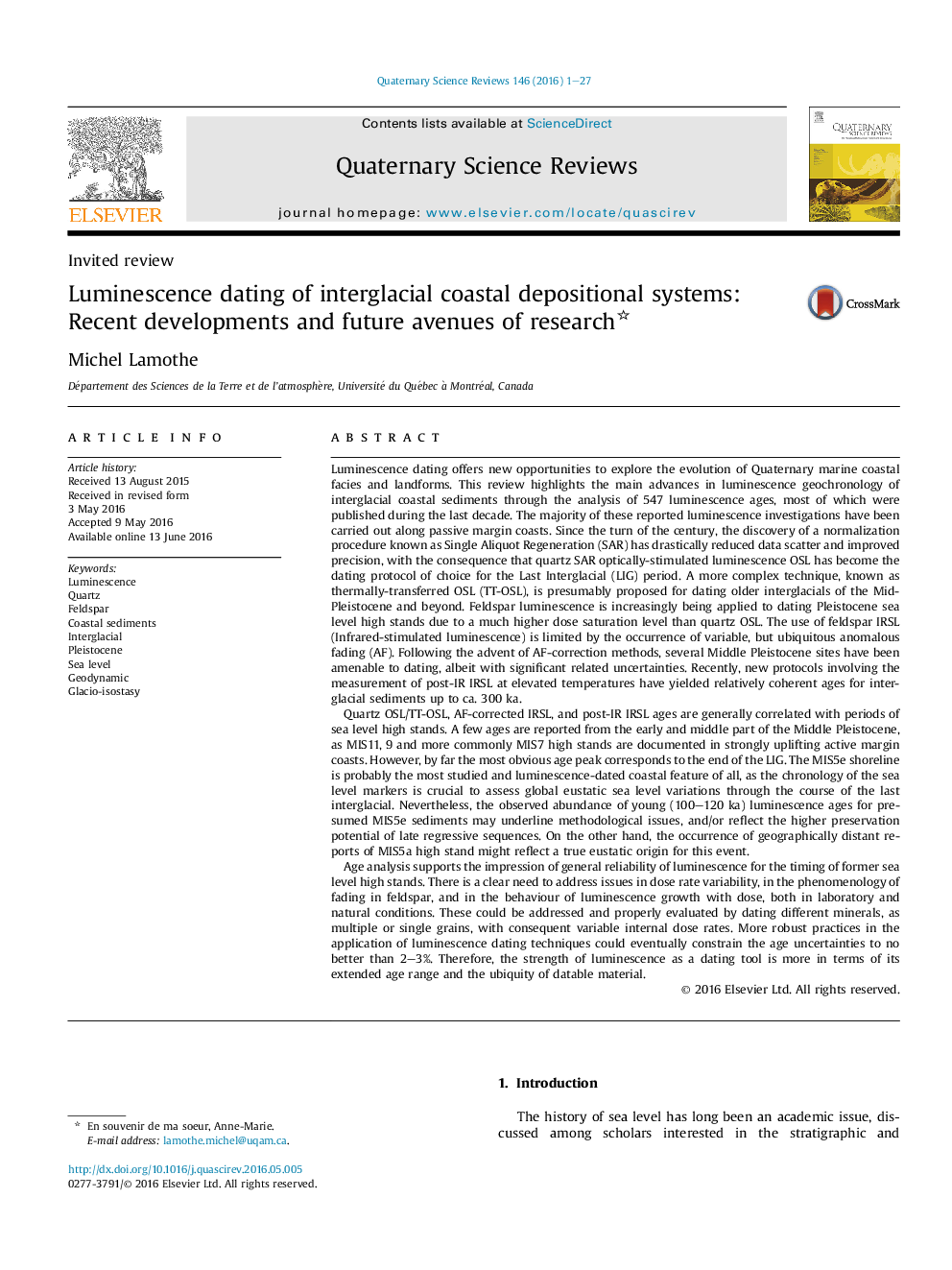| کد مقاله | کد نشریه | سال انتشار | مقاله انگلیسی | نسخه تمام متن |
|---|---|---|---|---|
| 4735262 | 1640789 | 2016 | 27 صفحه PDF | دانلود رایگان |
• This contribution synthesizes 72 papers in different geodynamic/GIA domains along coastal areas from every continent.
• The review synthesizes 547 luminescence ages, mostly obtained after 2000 CE; 82% are quartz OSL.
• Half of OSL/IRSL ages published are from MIS 5 sediments.
• Most reliable ages obtained when dating multiple minerals/dosimeters.
Luminescence dating offers new opportunities to explore the evolution of Quaternary marine coastal facies and landforms. This review highlights the main advances in luminescence geochronology of interglacial coastal sediments through the analysis of 547 luminescence ages, most of which were published during the last decade. The majority of these reported luminescence investigations have been carried out along passive margin coasts. Since the turn of the century, the discovery of a normalization procedure known as Single Aliquot Regeneration (SAR) has drastically reduced data scatter and improved precision, with the consequence that quartz SAR optically-stimulated luminescence OSL has become the dating protocol of choice for the Last Interglacial (LIG) period. A more complex technique, known as thermally-transferred OSL (TT-OSL), is presumably proposed for dating older interglacials of the Mid-Pleistocene and beyond. Feldspar luminescence is increasingly being applied to dating Pleistocene sea level high stands due to a much higher dose saturation level than quartz OSL. The use of feldspar IRSL (Infrared-stimulated luminescence) is limited by the occurrence of variable, but ubiquitous anomalous fading (AF). Following the advent of AF-correction methods, several Middle Pleistocene sites have been amenable to dating, albeit with significant related uncertainties. Recently, new protocols involving the measurement of post-IR IRSL at elevated temperatures have yielded relatively coherent ages for interglacial sediments up to ca. 300 ka.Quartz OSL/TT-OSL, AF-corrected IRSL, and post-IR IRSL ages are generally correlated with periods of sea level high stands. A few ages are reported from the early and middle part of the Middle Pleistocene, as MIS11, 9 and more commonly MIS7 high stands are documented in strongly uplifting active margin coasts. However, by far the most obvious age peak corresponds to the end of the LIG. The MIS5e shoreline is probably the most studied and luminescence-dated coastal feature of all, as the chronology of the sea level markers is crucial to assess global eustatic sea level variations through the course of the last interglacial. Nevertheless, the observed abundance of young (100–120 ka) luminescence ages for presumed MIS5e sediments may underline methodological issues, and/or reflect the higher preservation potential of late regressive sequences. On the other hand, the occurrence of geographically distant reports of MIS5a high stand might reflect a true eustatic origin for this event.Age analysis supports the impression of general reliability of luminescence for the timing of former sea level high stands. There is a clear need to address issues in dose rate variability, in the phenomenology of fading in feldspar, and in the behaviour of luminescence growth with dose, both in laboratory and natural conditions. These could be addressed and properly evaluated by dating different minerals, as multiple or single grains, with consequent variable internal dose rates. More robust practices in the application of luminescence dating techniques could eventually constrain the age uncertainties to no better than 2–3%. Therefore, the strength of luminescence as a dating tool is more in terms of its extended age range and the ubiquity of datable material.
Journal: Quaternary Science Reviews - Volume 146, 15 August 2016, Pages 1–27
